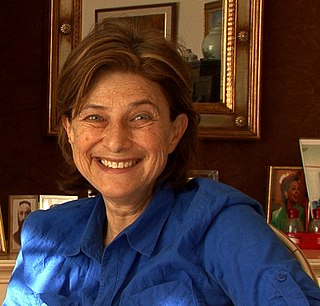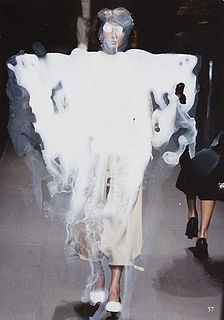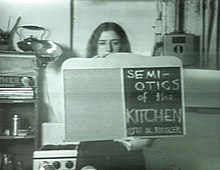
Julia Carolyn Child was an American cooking teacher, author, and television personality. She is recognized for bringing French cuisine to the American public with her debut cookbook, Mastering the Art of French Cooking, and her subsequent television programs, the most notable of which was The French Chef, which premiered in 1963.

Chantal Anne Akerman was a Belgian film director, screenwriter, artist, and film professor at the City College of New York. She is best known for Jeanne Dielman, 23 quai du Commerce, 1080 Bruxelles (1975), which The New York Times called a "masterpiece". According to film scholar Gwendolyn Audrey Foster, Akerman's influence on feminist and avant-garde cinema is substantial.

Ellen Henrietta Swallow Richards was an American industrial and safety engineer, environmental chemist, and university faculty member in the United States during the 19th century. Her pioneering work in sanitary engineering, and experimental research in domestic science, laid a foundation for the new science of home economics. She was the founder of the home economics movement characterized by the application of science to the home, and the first to apply chemistry to the study of nutrition.

Marxist feminism is a philosophical variant of feminism that incorporates and extends Marxist theory. Marxist feminism analyzes the ways in which women are exploited through capitalism and the individual ownership of private property. According to Marxist feminists, women's liberation can only be achieved by dismantling the capitalist systems in which they contend much of women's labor is uncompensated. Marxist feminists extend traditional Marxist analysis by applying it to unpaid domestic labor and sex relations.
Martha Rosler is an American artist. She is a conceptual artist who works in photography and photo text, video, installation, sculpture, and performance, as well as writing about art and culture. Rosler's work is centered on everyday life and the public sphere, often with an eye to women's experience. Recurrent concerns are the media and war, as well as architecture and the built environment, from housing and homelessness to places of passage and systems of transport.

Womanhouse was a feminist art installation and performance space organized by Judy Chicago and Miriam Schapiro, co-founders of the California Institute of the Arts (CalArts) Feminist Art Program and was the first public exhibition of Art centered upon female empowerment. Chicago, Schapiro, their students, and women artists from the local community, including Faith Wilding, participated. Chicago and Schapiro encouraged their students to use consciousness-raising techniques to generate the content of the exhibition. Together, the students and professors worked to build an environment where women's conventional social roles could be shown, exaggerated, and subverted.
Tracy + the Plastics is an American electropop and video project group from Olympia, Washington, United States. The members include Nikki Romanos on keyboard, Cola on drums, and Tracy as the lead vocals. Although the name implied the group was made up of a lead singer and back up musicians, all three characters were performed by Wynne Greenwood, a lesbian feminist artist using video projection, who calls herself a representative of the "lesbo for disco" generation.

Pipilotti Elisabeth Rist is a Swiss visual artist best known for creating experimental video art and installation art. Her work is often described as surreal, intimate, abstract art, having a preoccupation with the female body. Her artwork is often categorized as feminist art.

Christ in the House of Martha and Mary is an oil-on-canvas painting from Spanish artist Diego Velázquez, dating to his Seville period. Housed in the National Gallery, London, United Kingdom, it was painted in 1618, shortly after he completed his apprenticeship with Pacheco. At this time, Velázquez was experimenting with the potential of the bodegones, a form of genre painting set in taverns or kitchens which was frequently used to relate scenes of contemporary Spain to themes and stories from the Bible. Often they contained depictions of people working with food and drink.

Feminist art is a category of art associated with the late 1960s and 1970s feminist movement. Feminist art highlights the societal and political differences women experience within their lives. The hopeful gain from this form of art is to bring a positive and understanding change to the world, in hope to lead to equality or liberation. Media used range from traditional art forms such as painting to more unorthodox methods such as performance art, conceptual art, body art, craftivism, video, film, and fiber art. Feminist art has served as an innovative driving force towards expanding the definition of art through the incorporation of new media and a new perspective.

Kimberly Kane is an American pornographic actress.

Dara Birnbaum is an American video and installation artist. Birnbaum entered the nascent field of video art in the mid-to-late 1970s challenging the gendered biases of the period and television’s ever-growing presence within the American household. Her oeuvre primarily addresses ideological and aesthetic features of mass media through the intersection of video art and television. She uses video to reconstruct television imagery using materials such as archetypal formats as quizzes, soap operas, and sports programmes. Her techniques involve the repetition of images and interruption of flow with text and music. She is also well known for forming part of the feminist art movement that emerged within video art in the mid-1970s. Birnbaum lives and works in New York.
Bobby Baker is a multi-disciplinary artist and activist working across performance, drawing and multi-media. Baker is the artistic director of the arts organisation Daily Life Ltd. A hallmark of Baker's work is food being used as an artistic medium. As John Daniel writes, 'Food - shopping for it, cooking it, serving it, consuming it - is a consistent feature in Baker's work, which focuses on the seemingly mundane, everyday details of life' (2007:246) Drawing from her own personal and family experiences, her work explores the relationship between art and lived experience and addresses the splitting of women's domestic and professional lives. Claire MacDonald points out how her artistic trajectory - moving from early food sculptures to later performances and installations - reflects the changing agenda of women's movement.

Hannah Maud Hart is an American internet personality, comedian, author, and actress. She is known for starring in My Drunk Kitchen, a weekly series on YouTube in which she cooks something while intoxicated. She also runs a second channel where she talks about life in general and gives her opinions on various topics. She co-produced and starred in the independent comedy film Camp Takota, released in 2014. She wrote a parody cookbook which was a New York Times bestseller for five weeks in August–September 2014. She is a 2017 recipient of the Alex Awards.
Hip hop feminism is a sub-set of black feminism that centers on intersectional subject positions involving race and gender in a way that acknowledges the contradictions in being a black feminist, such as black women's enjoyment in hip hop music and culture, rather than simply focusing on the victimization of black women in hip hop culture due to interlocking systems of oppressions involving race, class, and gender.
Multimodality is the application of multiple literacies within one medium. For example, understanding a televised weather forecast (medium) involves understanding spoken language, written language, weather specific language, geography, and symbols. Multiple literacies or "modes" contribute to an audience's understanding of a composition. Everything from the placement of images to the organization of the content to the method of delivery creates meaning. This is the result of a shift from isolated text being relied on as the primary source of communication, to the image being utilized more frequently in the digital age. Multimodality describes communication practices in terms of the textual, aural, linguistic, spatial, and visual resources used to compose messages.

Joan Semmel is an American feminist painter, professor, and writer. She is best known for her large scale realistic nude self portraits as seen from her perspective looking down.
Mako Idemitsu is a pioneer Japanese media artist, known for her experimental video art and film works.
Pola Maria Weiss Álvarez, also known as Pola Weiss, was widely recognized as the first pioneer of video art in Mexico. She is also remembered for her experimental videos in which she merged dance and video, becoming a pioneer in what is now known as screendance or videodanza (videodance). She also worked as a television producer and instructor of film, video, and television.
Sorel Cohen is a Canadian photographer and visual artist currently living and working in Montreal, Quebec, Canada. She was represented by Donald Browne Gallery in Montreal until the gallery closed its doors in 2016.












